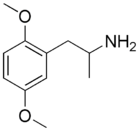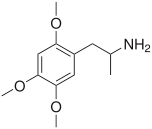
DOx
Encyclopedia

Substituent
In organic chemistry and biochemistry, a substituent is an atom or group of atoms substituted in place of a hydrogen atom on the parent chain of a hydrocarbon...
amphetamine
Amphetamine
Amphetamine or amfetamine is a psychostimulant drug of the phenethylamine class which produces increased wakefulness and focus in association with decreased fatigue and appetite.Brand names of medications that contain, or metabolize into, amphetamine include Adderall, Dexedrine, Dextrostat,...
derivatives featuring methoxy
Methoxy
In chemistry , methoxy refers to the functional group consisting of a methyl group bound to oxygen. This alkoxy group has the formula O–CH3.The word is used in organic nomenclature usually to describe an ether...
group
Functional group
In organic chemistry, functional groups are specific groups of atoms within molecules that are responsible for the characteristic chemical reactions of those molecules. The same functional group will undergo the same or similar chemical reaction regardless of the size of the molecule it is a part of...
s at the 2- and 5- positions of the phenyl ring
Simple aromatic ring
Simple aromatic rings, also known as simple arenes or simple aromatics, are aromatic organic compounds that consist only of a conjugated planar ring system with delocalized pi electron clouds. Many simple aromatic rings have trivial names. They are usually found as substructures of more complex...
, and a substituent
Substituent
In organic chemistry and biochemistry, a substituent is an atom or group of atoms substituted in place of a hydrogen atom on the parent chain of a hydrocarbon...
such as alkyl or halogen
Halogen
The halogens or halogen elements are a series of nonmetal elements from Group 17 IUPAC Style of the periodic table, comprising fluorine , chlorine , bromine , iodine , and astatine...
at the 4- position of the phenyl ring. The compounds of this class are potent
Potency (pharmacology)
In the field of pharmacology, potency is a measure of drug activity expressed in terms of the amount required to produce an effect of given intensity. A highly potent drug evokes a larger response at low concentrations, while a drug of lower potency evokes a small response at low concentrations...
and long-lasting
Half-life
Half-life, abbreviated t½, is the period of time it takes for the amount of a substance undergoing decay to decrease by half. The name was originally used to describe a characteristic of unstable atoms , but it may apply to any quantity which follows a set-rate decay.The original term, dating to...
psychedelic
Psychedelic drug
A psychedelic substance is a psychoactive drug whose primary action is to alter cognition and perception. Psychedelics are part of a wider class of psychoactive drugs known as hallucinogens, a class that also includes related substances such as dissociatives and deliriants...
drug
Drug
A drug, broadly speaking, is any substance that, when absorbed into the body of a living organism, alters normal bodily function. There is no single, precise definition, as there are different meanings in drug control law, government regulations, medicine, and colloquial usage.In pharmacology, a...
s, and act as highly selective
Functional Selectivity
Functional selectivity is the ligand-dependent selectivity for certain signal transduction pathways in one and the same receptor. This can be present when a receptor has several possible signal transduction pathways...
5-HT2A, 5-HT2B, and 5-HT2C receptor
Receptor (biochemistry)
In biochemistry, a receptor is a molecule found on the surface of a cell, which receives specific chemical signals from neighbouring cells or the wider environment within an organism...
partial agonist
Partial agonist
Partial agonists bind and activate a given receptor, but have only partial efficacy at the receptor relative to a full agonist...
s.
The DOx family includes the following members:
| Structure | Name | Abbreviation |
|---|---|---|
| 2,5-Dimethoxy-4-amylamphetamine | DOAM | |
| 2,5-Dimethoxy-4-bromoamphetamine 2,5-Dimethoxy-4-bromoamphetamine DOB, also known as Brolamfetamine and Bromo-DMA, is a psychedelic hallucinogenic drug and a substituted amphetamine of the phenethylamine class of compounds, which can be used as an entheogen. DOB was first synthesized by Alexander Shulgin in 1967... |
DOB | |
| 2,5-Dimethoxy-4-butylamphetamine | DOBU | |
| 2,5-Dimethoxy-4-chloroamphetamine | DOC | |
| 2,5-Dimethoxy-4-ethoxyamphetamine | MEM | |
| 2,5-Dimethoxy-4-ethylamphetamine 2,5-Dimethoxy-4-ethylamphetamine 2,5-Dimethoxy-4-ethylamphetamine is a psychedelic drug of the phenethylamine and amphetamine chemical classes. It was first synthesized by Alexander Shulgin, and was described in his book PiHKAL .- Chemistry :DOET is in a class of compounds commonly known as substituted amphetamines; its full... |
DOET | |
| 2,5-Dimethoxy-4-ethylthioamphetamine | Aleph-2 | |
| 2,5-Dimethoxy-4-fluoroamphetamine 2,5-Dimethoxy-4-fluoroamphetamine 2,5-Dimethoxy-4-fluoroamphetamine is a psychedelic drug of the phenethylamine and amphetamine classes. Alexander Shulgin briefly describes DOF in his book PiHKAL:- External links :*... |
DOF | |
| 2,5-Dimethoxy-4-(2-fluoroethyl)amphetamine | DOEF | |
| 2,5-Dimethoxy-4-iodoamphetamine 2,5-Dimethoxy-4-iodoamphetamine 2,5-dimethoxy-4-iodoamphetamine is a psychedelic drug and a substituted amphetamine of the phenethylamine family. It is also a powerful anti-inflammatory that is effective at doses on the order of 100 micrograms in humans, far below its effective dose as a psychedelic. Despite being a substituted... |
DOI | |
| 2,5-Dimethoxy-4-isopropylthioamphetamine | Aleph-4 | |
 |
2,4,5-Trimethoxyamphetamine | TMA-2 |
| 2,5-Dimethoxy-4-methylamphetamine 2,5-Dimethoxy-4-methylamphetamine 2,5-Dimethoxy-4-methylamphetamine is a psychedelic and a substituted amphetamine... |
DOM | |
| 2,5-Dimethoxy-4-methylthioamphetamine Aleph (psychedelic) Aleph, or 2,5-dimethoxy-4-methylthioamphetamine, is a psychedelic hallucinogenic drug and a substituted amphetamine of the phenethylamine class of compounds, which can be used as an entheogen. It was first synthesized by Alexander Shulgin. In his book PiHKAL , Shulgin lists the dosage range as... |
Aleph-1 | |
| 2,5-Dimethoxy-4-nitroamphetamine 2,5-Dimethoxy-4-nitroamphetamine 2,5-Dimethoxy-4-nitroamphetamine is an analogue of DOM and DOB. It is also closely related to 2C-N, and produces hallucinogenic, psychedelic, and entheogenic effects.-Chemistry:... |
DON | |
| 2,5-Dimethoxy-4-phenylthioamphetamine | Aleph-6 | |
| 2,5-Dimethoxy-4-propylamphetamine | DOPR | |
| 2,5-Dimethoxy-4-propylthioamphetamine | Aleph-7 | |
| 2,5-Dimethoxy-4-trifluoromethylamphetamine | DOTFM | |
As well as the following members with additional substitutions:
- 2,5-Dimethoxy-4-methyl-α-ethylphenethylamineAriadne (psychedelic)Ariadne , or 4-methyl-2,5-dimethoxy-alpha-ethylphenethylamine, is a lesser-known psychedelic drug. It is a homologue of 2C-D and DOM. Ariadne was first synthesized by Alexander Shulgin...
(Ariadne) - 2,5-Dimethoxy-4,N-dimethylamphetamineBeatrice (psychedelic)Beatrice, or 4-methyl-2,5-dimethoxymethamphetamine, is a lesser-known psychedelic drug. It is an analog of Methamphetamine and a homolog of DOM. Beatrice was first synthesized by Alexander Shulgin. In his book PiHKAL , the minimum dosage is listed as 30 mg, and the duration listed as 6–10 hours...
(Beatrice) - 2,5-Dimethoxy-3,4-methylenedioxyamphetamine (DMMDA)
- 2,5-Dimethoxy-3,4-dimethylamphetamineGanesha (psychedelic)Ganesha, or 2,5-dimethoxy-3,4-dimethylamphetamine, is a lesser-known psychedelic drug. It is also a substituted amphetamine. It was first synthesized by Alexander Shulgin. In his book PiHKAL , the dosage range is listed as 24–32 mg. Ganesha is sold in the form of dark red crystals...
(Ganesha) - 2,5-Dimethoxy-3,4-trimethylenylamphetamine (G-3)
- 2,5-Dimethoxy-3,4-tetramethylenylamphetamine (G-4)
- 2,5-Dimethoxy-3,4-norbornylamphetamine (G-5)
- 2,5-Dimethoxy-4-iodo-N,N-dimethylamphetamineIDNNAIDNNA, or 2,5-dimethoxy-4-iodo-N,N-dimethylamphetamine, is a lesser-known psychedelic drug and a substituted amphetamine. It is also the N,N-dimethyl analog of DOI. IDNNA was first synthesized by Alexander Shulgin. In his book PiHKAL , the minimum dosage is listed as 2.6 mg, and the duration...
(IDNNA) - 2,5-dimethoxy-4-bromo-N-methylamphetamineMethyl-DOBMethyl-DOB, or 4-bromo-2,5-dimethoxy-N-methylamphetamine, is a lesser-known psychedelic drug. It is similar in structure to DOB. Methyl-DOB was first synthesized by Alexander Shulgin. In his book PiHKAL , the minimum dosage is listed as 8 mg, and the effects onset begin after 3 hours and last...
(Methyl-DOB) - 2,3,4,5-Tetramethoxyamphetamine2,3,4,5-TetramethoxyamphetamineTetramethoxyamphetamine, or 2,3,4,5-tetramethoxyamphetamine, is a lesser-known psychedelic drug and a substituted amphetamine. Tetramethoxyamphetamine was first synthesized by Alexander Shulgin. In his book PiHKAL , the minimum dosage is listed as 50 mg, and the duration unknown...
(TA, TeMA)
External links
- PiHKAL ("Phenethylamines i Have Known And Loved") by Alexander "Sasha" ShulginAlexander ShulginAlexander "Sasha" Theodore Shulgin is an American pharmacologist, chemist, artist, and drug developer.Shulgin is credited with the popularization of MDMA, commonly known as ecstasy, in the late 1970s and early 1980s, especially for psychopharmaceutical use and the treatment of depression and...
(1991) - Psychotomimetic Drugs: Structure-Activity Relationships by Alexander "Sasha" ShulginAlexander ShulginAlexander "Sasha" Theodore Shulgin is an American pharmacologist, chemist, artist, and drug developer.Shulgin is credited with the popularization of MDMA, commonly known as ecstasy, in the late 1970s and early 1980s, especially for psychopharmaceutical use and the treatment of depression and...
(1978)

